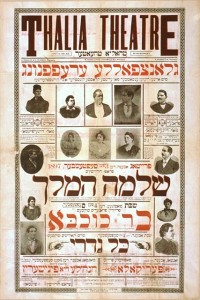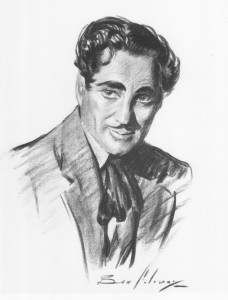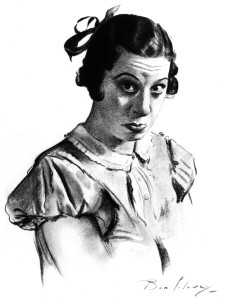
Color offset lithographic poster.
Immigrants continue to be in the news. While Central American immigrants are the focus of attention and sadly, scorn today, a century ago that attention and invective was aimed toward Jewish immigrants, primarily from Central Europe. Those that came to New York congregated on the Lower East Side of Manhattan and a remarkable culture blossomed there. One of the most visible aspects of this culture was the Yiddish Theatre, especially along Second Avenue, which would eventually be nicknamed “Yiddish Broadway.†“Next to the Yiddish press with its seven dailies…,†wrote the New York Times in 1925, “the idiomatic stage is the greatest power in the Jewish life of New York.â€
A new exhibition at the Museum of the City of New York, “New York’s Yiddish Theater: From the Bowery to Broadway,†opening March 9th explores this world and documents how not only its stars like Danny Kaye, Stella Adler, Eddie Cantor, crossed over to the American stage, film and television, but its plays, stage design, and music also filtered in the broader American culture leaving an indelible mark on the lives of generations of Americans.
Ben Solowey did not play an active role in the Yiddish Theater but he did draw charcoal portraits from life of many of its stars for the New York Times and the Herald Tribune including Maurice Schwartz, Anna Appel, Maurice Moscovitch, Fanny Brice, and Stella and Luther Adler. The Museum of the City of New York has asked to borrow two of Ben’s portraits of Yiddish Theater performers who made the successful transition to Broadway and beyond.

Joseph Buloff in My Sister Eileen, 1942
Joseph Buloff, who is best known today for originating the role of Ali Hakim the Peddler in Rodgers and Hammerstein’s Oklahoma!, was a mainstay of the Yiddish Theater. Even after he “crossovered†he continued to play in Yiddish Theater when not on Broadway and he worked to preserve the tradition for future generations. Just six months before he performed in Oklahoma!, Ben drew him in the hit, My Sister Eileen.
The second portrait to be loaned to the Museum will be Fanny Brice who built her career in part by using a Yiddish accent when ethnic comedy was the norm. This well-known portrait shows Brice as “Baby Snooks,†a character she created in vaudeville, played in the Ziegfeld Follies, before launching a very successful career in radio with a

Fanny Brice in The Ziegfeld Follies, 1933
show about the character.
The exhibition will feature a wonderful collection of material on the Yiddish Theater, as well as objects from the original production of Fiddler on the Roof, Boris Aronson set designs, Al Hirschfeld drawings, memorabilia from the Group Theatre, the Catskills, and much, much more.










